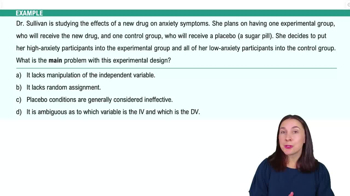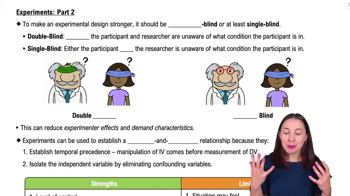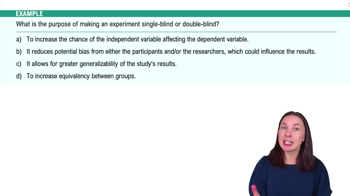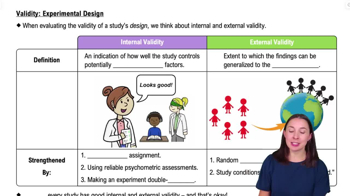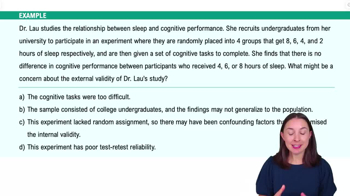Table of contents
- 1. Introduction to Psychology1h 43m
- 2. Psychology Research2h 20m
- 3. Biological Psychology2h 41m
- 4. Sensation and Perception28m
- 5. Consciousness and Sleep32m
- 6. Learning41m
- 7. Memory34m
- 8. Cognition37m
- 9. Emotion and Motivation35m
- 10. Developmental Psychology33m
- 11. Personality48m
- 12. Social Psychology41m
- 13. Stress and Health41m
- 14. Psychological Disorders44m
- 15. Treatment47m
2. Psychology Research
Intro to Research Methods
Struggling with Psychology?
Join thousands of students who trust us to help them ace their exams!Watch the first videoMultiple Choice
What is a key feature of a double-blind experiment
A
The researcher knows which group the participant is in, but the participant does not know.
B
The participant knows which group they are in, but the researcher does not know.
C
Neither the researcher nor the participant knows which group the participant is in.
D
Both the researcher and the participant know which group the participant is in.
 Verified step by step guidance
Verified step by step guidance1
Understand the concept of a double-blind experiment: It is a study design used to prevent bias in research results.
Recognize that in a double-blind experiment, neither the participants nor the researchers know who is receiving a particular treatment.
Identify the purpose of this design: It helps to eliminate bias from both the participants and the researchers, ensuring that the results are not influenced by expectations.
Compare the given options to the definition of a double-blind experiment.
Select the option that aligns with the definition: 'Neither the researcher nor the participant knows which group the participant is in.'

 1:46m
1:46mWatch next
Master Roadmap of the Lesson with a bite sized video explanation from Hannah Gordils
Start learningRelated Videos
Related Practice










